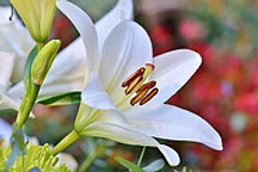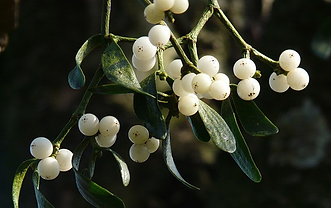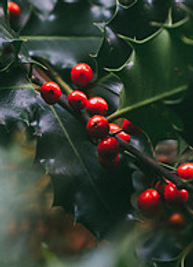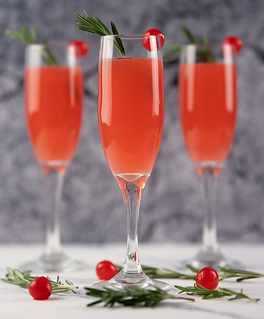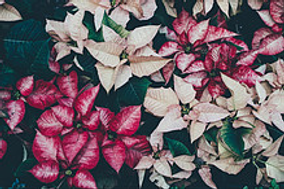
Seeing poinsettias in your local garden and grocery stores is a sure sign that the holidays are right around the corner.
Poinsettias along with Christmas cactus are a welcome sight in December. For me they conjure up images of cozy, softly-lit rooms, yummy aromas of ginger baked cookies, and a beautiful sea of reds, whites and pinks that dot your house with beauty. Read on to learn how to care for poinsettias, the meaning of a poinsettia, whether or not they’re safe for your furry friends, some cocktail ideas, and how to take care of a poinsettia beyond the holidays.
(Some of the links within this post are affiliate links on which I receive a small compensation for the sale of certain items with no extra cost to you.)
(As an Amazon Associate I earn from qualifying purchases.)
Care of a Poinsettia
Purchase a healthy plant:
When selecting a poinsettia, make sure you pick out a plant that is far away from the drafts of an entry door. The cold air may cause the leaves to yellow and drop when you get it home.
Choose a poinsettia that has tight bracts, the little yellow parts of the plant in the center of its flower. If they are compact, you have selected a healthy plant.
Check that the soil is moist. Do not choose one that is very light in weight (this indicates it has not been watered properly), dry to the touch, or dripping wet. You want to select a plant that was given proper care.
Care of your poinsettia begins on its ride home from the place of purchase. Be sure to have the plant wrapped in cellophane while in the store, and avoid exposure to a period of prolonged cold in a car.
Sun vs. Shade:
Poinsettias like bright diffused sun. Place it close to a window but not where it will be in a draft. The plant will survive in a more shaded area but the flowers may not last as long as they would if placed in diffused sunlight. Six to eight hours of bright diffused light is optimum.
Water Requirements:
Keep the plant slightly moist. The soil should be somewhat dry to the touch before watering the plant. In other words, water it about once per week in normal conditions. Do not allow it to dry out. Keep it damp but not sopping wet.
Fertilizer:
The poinsettia does not need fertilizing while in bloom. However, if you choose to keep the plant for a year or more, it will require a few doses of fertilizer. See below for how to keep the plant beyond the holidays.
Propagation:
You can successfully propagate (to breed a plant from the parent stock) a poinsettia from cuttings. After the plant has begun new growth in early summer, cut a stem three to six inches long. Sprinkle some root hormone powder (Amazon: Garden Safe Take Root Rooting Hormone) on a paper towel. After taking the cutting, dip the cut section of the stem into the root hormone. Then place it in a hole you have made in a pot filled with good pasteurized potting soil.
Water thoroughly. Place the small pot with the cutting in a secured plastic bag to create more humidity. Position it on a windowsill in bright indirect sunlight. In about a month, the cutting will produce roots and a root system. You can now remove it from the plastic bag.
Care Beyond the Holidays
A poinsettia will keep blooming well beyond the holidays. Maintain the same watering schedule as stated above. After blooming, with just some minor pruning and fertilizer you will be able to keep it alive until the next holiday season.
First Fertilization:
Once the beautiful bracts (colored leaves and yellow sections within the center) fall off, wait 6 weeks and then fertilize it with 1/2 a solution of good indoor plant fertilizer (Amazon: JR Peters All Purpose Fertilizer). Water it until it seeps from the drainage holes in the bottom of the pot.
Second Fertilization:
Fertilize the plant with the same solution six weeks after the first fertilizing.
Pruning:
In early May, use scissors to prune the plant back to 8 inches tall. Place the plant in a sunny window and continue the same watering regimen.
Fertilize New Growth:
Around the end of May you should see some new growth. Fertilize the plant at this time with 1/2 of the same solution used above.
Move Outside:
After fertilizing and new growth has appeared, move it outside in June for the summer months. Keep it out of direct sunlight for the leaves will burn if exposed to direct sun. Also, continue watering the plant. Monitor the soil moisture by touching it with your finger. It needs to stay slightly moist, not soggy or dry. This is more tricky to track since you are dealing with the outside elements.
Transplant the Poinsettia:
At the end of June, transplant your poinsettia into a pot 4 inches in diameter larger than the original one. Shake the soil off the roots and place the plant in a sterile, soil-less potting mix (Amazon: Noot Rescue Soilless Rooting Mix) that contains peat moss.
Water and Fertilize after Repotting:
Give your newly transplanted flower a 1/2 solution of fertilizer listed above. Be sure to fertilize the plant until the liquid solution drains from the holes in the bottom of the pot. You may need to add more potting mix after it is thoroughly watered.
Fertilize Once Per Month:
Continue fertilizing the plant with the same solution one time per month. Keep up the same watering regimen so the soil does not dry out.
Encourage Flowering:
Beginning October 1st, place the plant in a box with a lid from 5pm to 8am. It must have complete darkness and remain in a constant temperature between 65 and 70 degrees Fahrenheit. For the remaining hours, place the plant in a sunny location.
Maintain Soil Moisture:
Continue putting the plant in darkness until Thanksgiving. By then your plant should have beautiful, but not as colorful, bracts. The colors will begin to darken once in the sunlight. Also, be sure the soil is moist to the touch but not soggy.
Place in Indirect Sunlight:
At Thanksgiving, (the end of November), place your plant in a space where it gets indirect sunlight.
If this sounds like too much work, compost the plant after it blooms and buy a new plant next season!!
Meanings of Poinsettia
The poinsettia is native to southern Mexico. Ancient Aztecs considered it to be a symbol of purity. It has since evolved to symbolize good cheer and success.
It is also the flower of the month of December. By giving a poinsettia as a gift, you are bringing wishes of mirth (laughter, gladness, and merriment) and celebration.
Our Furry Friends
Many people are under the impression that poinsettias are deadly to cats and dogs. However, according to Pet Poison Hotline, they are only mildly toxic to cats and dogs. If ingested, the white sap may cause mild diarrhea, vomiting and drooling. On a rare occassion it can causes mild conjunctivitis, “pink eye”. The sap can also be an irritant to the skin and cause some redness, swelling and itchiness.
All this said, these symptoms are minimal and will likely heal on their own. They rarely need medical attention.
However, to protect your pets, beware of these three very poisonous plants around the holidays!!
Champagne Cocktail From Mix That Drink
Ingredients:
- Champagne
- 1/2 ounce Cointreau
- 3 ounces Unsweetened Cranberry Juice
Directions:
- Place the cranberry juice and Cointreau in a chilled champagne flute
- Stir
- Top with champagne
Top it off with a sprig of rosemary and a few cranberries.
Non-Alcoholic Variation from A Couple Cooks
Replace the same amounts of alcohol with non-alcoholic sparkling cider or grape juice for the champagne and orange juice for the Cointreau.
Conclusion – How to Take Care of Poinsettias
Choose a healthy plant, water it properly, give it the correct amount of light, and enrich it with fertilizer. This will almost guarantee a beautiful plant to adorn your home during the holidays. Also, you can propagate the plant to share with friends and family. Be adventurous and try the above process for maintaining the plant beyond the holidays!
I hope you enjoyed this article. Please leave a comment and share it with others.
Let me know how you make out maintaining your poinsettia throughout the year!
Happy Gardening and Happy Holidays!
Nina

